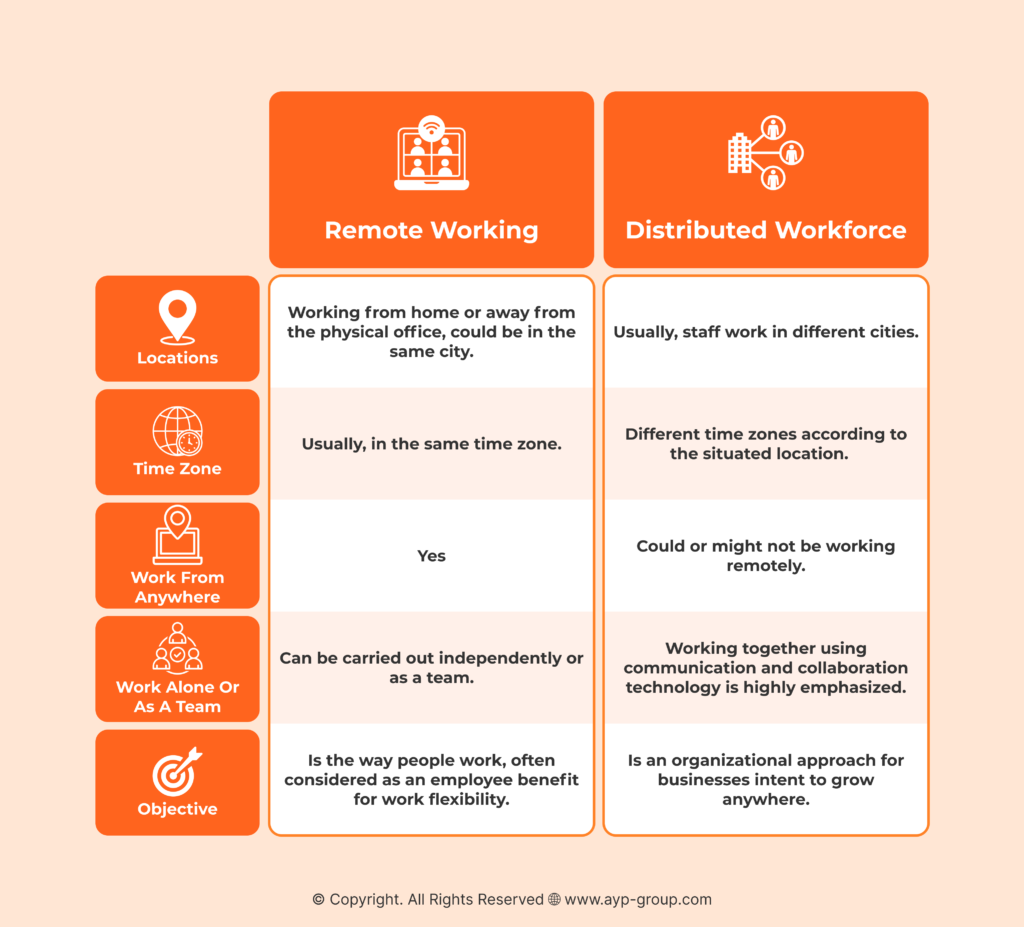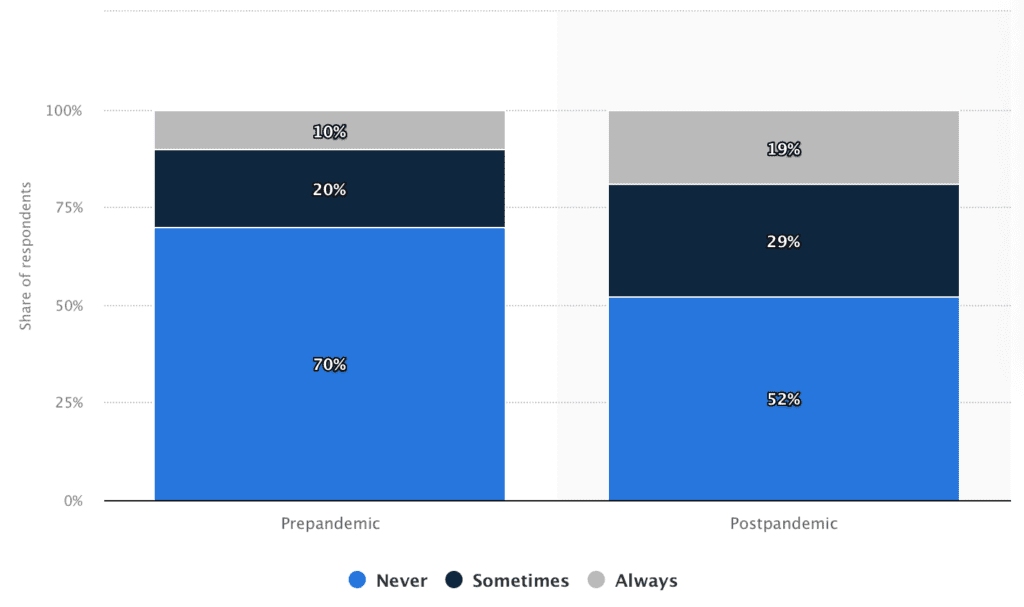Table of Contents
showSpending too much on recruitment, payroll or global HR?
We help you find the Best Providers at the lowest cost.
Key Takeaways
The distributed workforce model offers numerous benefits, such as cost savings, access to a global talent pool, and improved employee satisfaction.
Organizations should implement strategies to effectively manage their distributed teams by setting clear expectations and goals, fostering team-building connections, and encouraging continuous learning & development.
Real-life examples of successful distributed workforces demonstrate the potential for greater innovation & success through leveraging this approach.
What is a distributed workforce?
The world of work is changing rapidly, and one major shift is the rise of the distributed workforce. Imagine a world where talented individuals can contribute to a company’s success, regardless of geographical location, where employees can work from home, a coffee shop, or even from another country while still collaborating effectively with their coworkers.
This is the reality for many organizations today as they embrace the benefits of a distributed workforce model. In this blog post, we will explore the concept of “what a distributed workforce is,” its key components, benefits, challenges, and best practices for managing a distributed team successfully.
So, what does a distributed workforce look like? And how has it evolved to become a viable alternative to the traditional office environment? Let’s dive in and find out what a distributed workforce is and its impact on the modern work landscape.

Understanding the Distributed Workforce Model
A distributed workforce involves employees working remotely and leveraging digital tools to facilitate collaboration and achieve shared objectives in remote and distributed work. This model, the distributed workforce function, has gained popularity due to technological advancements, shifting employee preferences, and the need to respond to global challenges such as the COVID-19 pandemic.

The location flexibility offers the company and its personnel numerous competitive benefits, including:
- Reduced commuting time
- Access to a global talent pool
- Enhanced employee satisfaction and retention
- Cost savings and reduced overhead for employees working in different locations.
However, certain challenges accompany the management of a distributed workforce, including issues with communication and collaboration, preserving company culture, and dealing with time zone discrepancies. Clear expectations, fostering team cohesion, and promoting continuous learning are essential strategies to address these challenges and effectively manage a distributed workforce.
Key Components of a Distributed Workforce
At its core, a distributed workforce comprises remote personnel, satellite office personnel, and co-working space members, all collaborating using digital tools and platforms to support distributed workers. This model can foster diversity, encouraging innovative thinking, ingenuity, and effective communication among team members working from multiple locations. Remote workers, for example, may consist of one or more employees who typically work in the same geographic area or time zone, with occasional visits to the company’s main office for face-to-face meetings.
Distributed workforces offer numerous advantages, such as cost savings and reduced overhead, access to a global talent pool, and enhanced employee satisfaction and retention, even for those working from a local coffee shop. However, managing a distributed workforce can present challenges, such as communication and collaboration issues, maintaining company culture, and navigating time zone differences.
A combination of essential tools is necessary to challenges and guarantee the success of a distributed workforce and technologies tackle these ch. These include project management and workflow platforms, communication and video conferencing apps, and employee engagement and recognition tools, all contributing to the smooth functioning of a distributed workforce.
The Evolution of Distributed Workforces
The evolution of distributed workforces has been driven by advancements in technology, changing employee preferences, and the need to adapt to global challenges. As digital tools and technologies have advanced, companies have maintained communication and collaboration among employees, even when they are not in the same physical location. This has allowed organizations to tap into a global talent pool, providing access to the most suitable talent for their requirements, irrespective of geographical boundaries.
Distributed workforces encounter obstacles such as maintaining effective communication, and collaboration, preserving corporate culture, and managing disparate time zones. The effective management of a distributed workforce involves employing essential tools and technologies, including project management and workflow platforms, communication and video conferencing applications, and employee engagement and recognition tools.
Benefits of Embracing a Distributed Workforce
Adopting a distributed workforce can bring numerous advantages, such as:
- Reduced overhead
- Increased diversity
- Access to talented personnel
- Cost efficiency
- Enhanced employee satisfaction
Reducing the necessity for physical office spaces, including satellite offices, and associated expenses can result in significant cost savings for companies.
Furthermore, having access to a global talent pool allows companies to source the most suitable talent for their requirements, irrespective of geographical boundaries.
A distributed workforce can also offer improved employee satisfaction through increased flexibility in work hours, autonomy, and the ability to work remotely. This flexibility can lead to a better work-life balance for employees, resulting in higher job satisfaction and increased retention rates.
Cost Savings and Reduced Overhead
One of the primary benefits of a distributed workforce is the potential for cost savings and reduced overhead. By minimizing the need for physical office spaces, companies can save on office rent, utilities, and maintenance expenses. This can make a significant difference in the financial health of an organization, allowing for more resources to be allocated to other projects or initiatives.
In addition to savings on office space, a distributed workforce can lead to savings in travel, equipment, and other overhead expenses. As employees work remotely, the need for company-funded travel and equipment may decrease, further contributing to the cost-saving benefits of a distributed workforce.
Access to a Global Talent Pool
One of the most significant advantages of a distributed workforce model is access to a global talent pool. By sourcing talent from around the world, companies can recruit the most suitable candidates for their needs, regardless of geographical location. This results in a more diverse and proficient workforce, creating more significant potential for innovation, problem-solving, and customer engagement.
A McKinsey analysis revealed that executive teams with greater gender diversity were 25% more likely to experience higher profitability than those with lower diversity, and those with higher ethnic diversity had a 36% greater chance of profitability.
By embracing a distributed workforce model, companies can benefit from the unique perspectives, skills, and experiences a diverse team can bring. This diversity can contribute to a more vibrant company culture, increased productivity, and a more successful business.
Improved Employee Satisfaction and Retention
A distributed workforce model can positively impact employee satisfaction and retention. Employees may feel more engaged and motivated in their roles by offering flexibility, better work-life balance, and opportunities for personal growth. This can lead to higher retention rates and overall success for the organization.
Companies can enhance employee satisfaction and retention in a distributed workforce by encouraging time off, regular one-on-one sessions, and adapting traditional in-office activities to a virtual setting. Utilizing necessary tools and technologies, including project management and workflow platforms, communication and video conferencing apps, and employee engagement and recognition tools, can aid in creating a supportive and connected remote work environment.
Challenges and Solutions for Managing a Distributed Workforce
While there are many benefits to embracing a distributed workforce, it’s important to acknowledge the challenges that can arise in managing a distributed team. Some of these challenges include:
- Communication and collaboration difficulties when team members are located in different time zones or working environments
- Maintaining company culture and a sense of belonging among remote employees
- Navigating time zone differences and coordinating meetings
It’s important to be aware of these challenges and implement strategies to overcome them to manage a distributed team effectively.
To effectively manage a distributed workforce and overcome associated challenges, companies should define clear expectations, promote team cohesion, and encourage continuous learning. The right blend of tools and technologies, such as project management and workflow platforms, communication and video conferencing apps, and employee engagement and recognition tools, can bolster remote employees’ experience and contribute to a successful distributed workforce.
Communication and Collaboration
Clear communication and collaboration are essential for a successful distributed workforce. Utilizing the right tools and platforms can help bridge the gap between team members, ensuring everyone is on the same page and working toward common goals. This can include instant messaging apps, video conferencing tools, and project management platforms that facilitate real-time communication and collaboration.
In addition to using the appropriate tools, establishing clear policies regarding the frequency and channels for different types of communication is crucial. For instance, a policy that no one is expected to respond to communications sent after work hours, except in the case of an emergency, can be implemented to respect employees’ time. This promotes a healthy work-life balance and ensures team members feel supported and valued.
Maintaining Company Culture
Maintaining company culture in a distributed workforce requires effort and creativity. Companies can organize virtual team-building activities, such as:
- Online games for team building
- Virtual happy hours
- Virtual team lunches
- Virtual team retreats
These activities foster connection and camaraderie among remote employees. Recognition programs, such as awards, bonuses, and other forms of recognition for employees demonstrating exemplary performance, can also help maintain a strong company culture.
In addition to these activities, fostering a sense of belonging through collaboration, constructive feedback, and cultivating a sense of community can help maintain a strong company culture in a distributed workforce. Companies can ensure a successful and thriving distributed workforce by creating an environment where employees feel valued and connected.
Navigating Time Zone Differences
Navigating time zone differences can be challenging when managing a distributed workforce. However, teams can work effectively across multiple time zones with proper planning, communication, and flexibility. Teams should plan, communicate clearly, and remain flexible to ensure effective collaboration across time zones.
Asynchronous work, characterized by a lack of expectation for real-time communication, can also be utilized to accommodate time zone differences. Companies can support productivity and collaboration regardless of time zone differences by allowing team members to work independently and communicate at their own pace.
Essential Tools and Technologies for a Successful Distributed Workforce
Companies should equip their teams with essential tools and technologies to support a successful distributed workforce, such as project management platforms, communication apps, and employee engagement tools. These tools facilitate communication and collaboration among remote employees and help maintain company culture, boost morale, and encourage productivity.
Next, we will explore in-depth the specific tools and technologies underpinning a distributed workforce’s success. These include project management and workflow platforms, communication and video conferencing apps, and employee engagement and recognition tools.
Project Management and Workflow Platforms
Project management and workflow platforms are software solutions designed to facilitate teams in maintaining organization, monitoring progress, and collaborating efficiently. These platforms can help teams:
- Stay organized
- Track progress
- Collaborate effectively
- Ensure that projects are completed on time and within budget.
Some popular project management and workflow platforms include:
- Trello
- ClickUp
- ProofHub
- Scoro
- Asana
These platforms offer various features, such as task assignment, deadline tracking, file sharing, and communication tools, which can help distributed teams work together seamlessly and efficiently.
Communication and Video Conferencing Apps
Communication and video conferencing apps are digital platforms that facilitate real-time interaction, promoting connection and cooperation among colleagues. Some benefits of using these apps include:
- Facilitating remote collaboration and teamwork
- Saving time and money on travel expenses
- Increasing productivity by allowing for quick and efficient communication
- Enhancing engagement and participation in meetings through video chat
By utilizing these apps, organizations can create a more connected and engaged workforce, regardless of geographical location.
Some popular communication and video conferencing apps include:
- Zoom
- Skype
- Google Hangouts
- Slack
These apps allow team members to communicate and collaborate effectively, bridging the gap between remote employees and strengthening the overall connection within the distributed workforce.
Employee Engagement and Recognition Tools
Employee engagement and recognition tools can help maintain company culture, boost morale, and encourage productivity in a distributed workforce. These tools can include platforms that facilitate employee feedback and recognition, such as Officevibe, which can be integrated with other applications to measure and evaluate team feedback.
Other employee engagement tools might focus on providing resources for personal and professional development, such as online courses, mentorship programs, or opportunities for employees to share their knowledge. By providing access to these resources and recognizing employees for their efforts, companies can create a supportive and connected remote work environment that fosters engagement and productivity.
Best Practices for Managing a Distributed Workforce
Securing the success of a distributed workforce necessitates the implementation of best practices that cater to the distinctive challenges and opportunities arising from remote work. Essential strategies for effective management include establishing clear expectations, promoting team cohesion, and advocating for continuous learning and development.
Next, we will delve into these best practices, offering practical advice and strategies applicable to managing a distributed workforce.
Setting Clear Expectations and Goals
Setting clear expectations and goals is essential for the success of a distributed workforce to ensure that all personnel understand their roles and obligations. Managers can effectively set expectations and goals by clearly conveying the desired outcomes, supplying resources and support, and establishing measurable goals.
Comprehending roles and responsibilities is essential for distributed teams, as it helps guarantee that everyone is cognizant of their duties and how they contribute to the team’s total success.
To ensure effective collaboration and productivity, managers can take the following steps:
- Establish realistic objectives for each team member.
- Provide regular feedback and assistance to help team members achieve their goals.
- Cultivate a culture of trust and cooperation within the team.
By implementing these strategies, managers can successfully set expectations and goals for their distributed teams.
Fostering Team Building and Connection
Team building and connection is essential for upholding a sound corporate culture and encouraging cooperation in a distributed workforce. Organizing recurrent team meetings can help all personnel to feel they are part of the same objective. Additionally, offering chances for team members to become more acquainted with one another, such as virtual happy hours or team-building exercises, can help construct relationships and trust.
By establishing clear objectives and expectations, promoting ongoing learning and development, and supplying tools and technologies to enable communication and collaboration, companies can foster team building and connection among their distributed workforce.
Encouraging Continuous Learning and Development
Continuous learning and development are essential for employees to remain engaged, motivated, and equipped to handle the changing business environment. Companies can foster continuous learning and development by providing access to online courses, instituting mentorship programs, and creating opportunities for employees to share their knowledge.
Additionally, providing feedback and recognition for employees’ efforts can serve as a motivator to continue learning and developing their skills. By investing in the professional growth of their employees, companies can ensure a successful and thriving distributed workforce.
Real-Life Examples of Successful Distributed Workforces
Examples of successful distributed workforces are in companies like Chess.com, Upwork, and GitLab. These organizations have effectively leveraged the benefits of a distributed workforce model to achieve growth and success, tapping into the cost savings and access to a global talent pool that this model offers.
These real-life examples demonstrate the potential of a distributed workforce to transform the way companies operate, allowing them to achieve greater flexibility, innovation, and success in an ever-evolving business landscape.
Summary
In conclusion, the distributed workforce model presents many opportunities for companies and employees. By embracing this model, organizations can access a global talent pool, reduce overhead costs, and improve employee satisfaction and retention. However, managing a distributed workforce presents unique challenges, such as communication and collaboration, maintaining company culture, and navigating time zone differences.
By implementing best practices and leveraging the appropriate tools and technologies, companies can successfully manage a distributed workforce, fostering a strong company culture, promoting collaboration, and ultimately achieving growth and success in an ever-changing business landscape.
FAQ
Often distributed teams work remotely. But they do not need to do so. For example, a company with multiple one-person offices all over the country could say it had a distributed team, even though those individuals did not work remotely.
They can do so. If the distributed team works remotely this may save a company on all the costs associated with running a physical office.
A distributed workforce provides improved employee engagement, increased productivity, access to a larger talent pool, flexible hours, and a healthier work-life balance; these are all essential advantages of using this model in the workplace.
An example of a distributed team is one where the team members are geographically separated, often in multiple time zones, yet connected to collaborate on specific projects due to their unique skills and knowledge base.
Remote work is when individuals are geographically dispersed, yet still connected to a central office. On the other hand, distributed workforce is when an entire organization follows a set of rules and practices that allow employees to work from various locations.
A distributed workforce involves employees working remotely and leveraging digital tools to collaborate and achieve shared goals, allowing for greater flexibility and convenience.
Managing a distributed workforce can be challenging due to communication and collaboration issues, difficulty preserving company culture, accounting for time zone differences, and ensuring the best recruitment processes.


